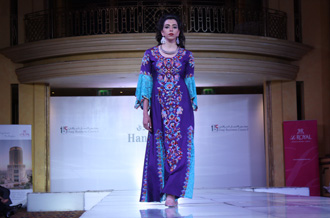Iraqi designer seeks unity through fashion
Fashion designer Hana Sadiq says incorporating traditional patterns from across the Middle East can inspire Arab unity.

Amman, Jordan – Models strolled up and down the white runway wearing bold designs and striking colours, as the music of an Iraqi santur mingled with that of a piano being played in the background. While it may have appeared to be a standard fashion show, in the threads, beads, and stitches lay a political message: a call for Arab unity.
“We have been torn into many pieces, and now it is time to rethink our goals of unity,” said Iraqi fashion designer Hana Sadiq, from the sidelines of a fashion show in the Jordanian capital, Amman.
Keep reading
list of 4 itemsFire engulfs iconic stock exchange building in Denmark’s Copenhagen
Inside the pressures facing Quebec’s billion-dollar maple syrup industry
‘Accepted in both [worlds]’: Indonesia’s Chinese Muslims prepare for Eid
“Even artists have become afraid to talk about politics and play their role in conveying messages through their work,” added Iraqi musician Azhar Kubbah, who composed the music for the show.
We have been torn into many pieces, and now it is time to rethink our goals of unity.
Known for integrating Arabic calligraphy into haute couture, Sadiq travelled to countries in the Middle East and North Africa, seeking out traditional designs to incorporate into her spring/summer 2014 collection.
But the designer said that the region’s myriad of political divisions have also spread to the arts. “Unfortunately, even artists have accepted the idea that art or designs are different across countries,” said Sadiq, who has resided in Jordan since leaving Iraq in 1970. “Arab culture is one and it has no borders.”
RELATED: Women keep Jordan’s traditions alive
When she first used Arabic calligraphy in her designs 25 years ago, Sadiq stirred controversy among some religious groups. “They said I was using the language of the Quran in fashion and that it was unacceptable,” she recalled. “When I explained that the words were love poetry and not the Quran, they said ‘she is encouraging debauchery’.”
Since that time, Sadiq’s work has continued to stir debate about the role of art and design in the politics of the region.
Jordanian designer Intissar Khalifah, who works in Palestinian fashion, said that mixing patterns from various Arab countries, like Sadiq does, can help preserve the region’s rich heritage.
 |
| Sadiq used a Palestinian cross-stitch for the embroidery on this dress [Areej Abuqudairi/Al Jazeera] |
“Sadiq’s work is so important at a time when our heritage is not only being neglected, but also threatened by all the unrest,” Khalifah told Al Jazeera. “Artists have a national duty to protect their culture from disappearing.”
Other designers, however, believe that preserving the traditional designs of their national dresses is key to maintaining their identity.
“It is best for each country to keep its designs and patterns to protect its own identity,” said Mariam Abu-Labban, a Palestinian-Jordanian designer, who refuses to change the basic cut of a thawb, or dishsasha, into a more Westernised form.
“We have to teach it to our children… and pass it on to them.”
RELATED: Waiting longer to marry in Jordan
For admirers of traditional Arab dresses like Reema Awartan, a Jordanian collector of Sadiq’s work, wearing such pieces is more about fashion. “The work is like a painting. It is timeless and it knows no geographical or thematic restrictions,” Awartan told Al Jazeera.
“Looking at these designs, I think it speaks to my feminine side as an Arab woman, and reconnects me with my culture and heritage,” she said, from the sidelines of Sadiq’s fashion show in Amman.
According to Sadiq, teaching younger generations about the history of Arab fashion is as important as teaching them about the history of their own countries.
“Nowadays, you can see dresses and shirts Arabic calligraphy written on them everywhere in markets in Egypt, Syria, and Jordan,” she said. “If we offer young people old designs in beautiful and modern ways, they will accept them and wear them.”